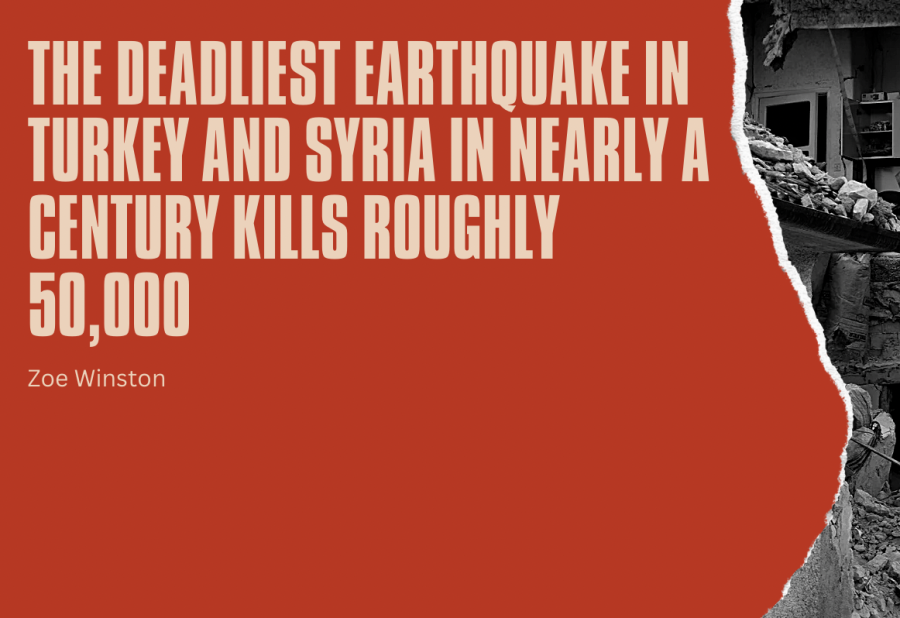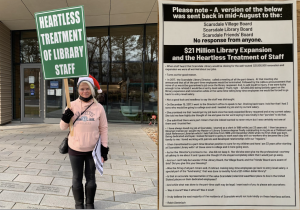The Deadliest Earthquake in Turkey and Syria in Nearly a Century Kills Roughly 50,000
On the morning of Monday, February 6th, a 7.8 magnitude earthquake struck Turkey and Syria, turning neighborhoods to piles of rubble in its wake.
March 2, 2023
On the morning of Monday, February 6th, a 7.8 magnitude earthquake struck Turkey and Syria, turning neighborhoods to piles of rubble in its wake. In the first 24 hours, approximately 6,000 buildings crumbled, tragically trapping or killing countless people. The epicenter of the earthquake was located just 20 miles from Gaziantep, a southeastern Turkish city. Additionally, the quake heavily impacted the northern border of Syria. The death toll currently stands at 46,000 and continues to rise, while roughly 13 million individuals have been impacted by the disaster. The quake’s effects have also been felt in Jordan, Iraq, Israel, and Lebanon.
Turkey sits on the intersection of two fault lines. The earthquake on February 6th was Turkey’s deadliest in almost 100 years. “My initial reaction to the earthquake was a concern because I knew the last time an earthquake this bad happened in Turkey was in ’99, and lots of people sadly died,” Devin Topkara ’26 said. Although Topkara’s family members who live in Turkey were not affected by the earthquake, she remains concerned for the country’s state and those trapped.
The time and location of the earthquake made its impact more destructive. The earthquake happened in the morning, so people were still in their homes when their buildings collapsed. These people were then trapped or killed in their once homes, with many of those trapped experiencing freezing temperatures. Over 25,000 search and rescue workers from Turkey have been working to pull people out of the rubble. Sadly, most of these rescues have not found those who endured the destruction.
Due to the conflict going on in Syria, sending relief to Turkey and Syria has been difficult. Turkey’s foreign minister reminded that “it’s a humanitarian situation and not a political one.” The U.S. military began relief efforts on February 10th, and the U.S. Air Force delivered over 5,700 tons of life-saving equipment and disaster aid on February 11th. A spokesman for the UN secretary-general told the BBC it was time “to put all politics aside” to deliver aid to Syria. Two German relief groups, the German International Search and Rescue (ISAR), and Germany’s Federal Agency for Technical Relief (THW), have halted their assistance out of fear of the security of the situation. They said they would resume work when the Turkish Civil Protection Agency, Afad, classifies the situation as safe. Though eventually restoring it, the Austrian Forces Disaster Relief Unit, Afdru, also briefly suspended their aid on February 11th. Switzerland sent specialists and rescue teams to help the situation but has been monitoring the situation closely. Those affected by the earthquake in Syria received no aid on the day of the quake, only the dead bodies of their loved ones. One reason for delayed aid from Turkey was due to wreckage on the roads. However, even two days after the earthquake, Syrians still received no aid from Turkey despite promises from the UN. The UN is working to open more border crossings between Turkey and Syria to send aid. On a positive note, a border crossing between Armenia and Turkey is open to allow relief to pass through. This was the first time borders between the two countries had opened in 35 years.
There are many ways you can help. The United Nations World Food Program and children’s agencies are working to bring relief and support to those affected by the earthquake.
“The Turkish embassy is currently not collecting more clothes; however, they are collecting blankets. Additionally, money donations are great,” reminded Topkara. The Syrian American Medical Society, a U.S.-based charity, provides relief efforts to those affected in Syria.
The death toll from earthquakes continues to rise each day as bodies are recovered. However, a number of people have been pulled out of the destruction. “Due to technology being more advanced, more people could be saved from the rubble; many people were able to text, tweet, or in other means get out their exact addresses and where they were from under the rubble.” reminded Topkara.
























